My all time favorite holiday plant is amaryllis and I have seen many
in stores that
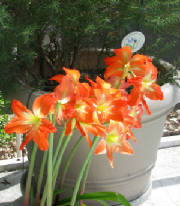
are just putting up their bloom stalks. But, holiday
cactus, cyclamen, kalanchoe, red or white begonias and impatiens, even a topiary rosemary tree are also popular choices.
When choosing plants with blooms, look for those with only a few blooms open and plenty of buds, healthy foliage and a compact
form. For amaryllis, look for plants with the bloom stalk part way up and the bud well formed. Be cautious if you purchase
an amaryllis in one of the prepackaged boxes, be sure to open the box to see if the bulb has already sprouted a bloom stalk
that is twisted inside the box. These bloom stalks will not straighten, so only choose those with bulbs that are not
sprouted or are just beginning to sprout.
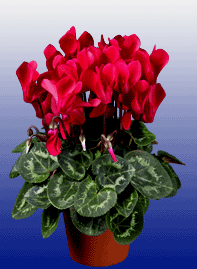 The most crucial tip for keeping these plants looking
good through the holidays is proper watering. Make sure that the pot containing the plant has bottom drainage holes.
Plants in small containers can dry out quickly, so you should check them daily. Put your finger in the soil, if the
top inch is dry it is time to water. Over watering is just as bad is under watering and plants do not like to sit in
water. If they come in a decorative foil or plastic wrapper covering the pot, take it off or punch holes in it, then
water them and let them drain well before placing it on a water proof container to protect your table tops.
The most crucial tip for keeping these plants looking
good through the holidays is proper watering. Make sure that the pot containing the plant has bottom drainage holes.
Plants in small containers can dry out quickly, so you should check them daily. Put your finger in the soil, if the
top inch is dry it is time to water. Over watering is just as bad is under watering and plants do not like to sit in
water. If they come in a decorative foil or plastic wrapper covering the pot, take it off or punch holes in it, then
water them and let them drain well before placing it on a water proof container to protect your table tops.
Keep
blooming plants in cooler temperatures to preserve the blooms longer. Cyclamen prefer very cool temperatures, so if
you place them in a protected area
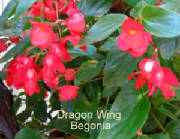
outside over night when no frost is predicted, the blooms will
last longer. Be sure to bring them inside in the morning before any sun reaches the plants. The other plants listed
should be placed in areas with high levels of bright light but no direct sun. Also, keep them out of drafts; either
cold from a door or in front of air-conditioning or heating vents.
After the holidays, all of
the mentioned plants except the cyclamen can be added to your landscape. I call Amaryllis the Florida tulip, the bulbs
will thrive and multiply in well drained soil in a site with morning sun and some dappled afternoon shade. I plant several
in large pots so that I can protect them from hungry deer. They bloom around March or April every year. The bulb
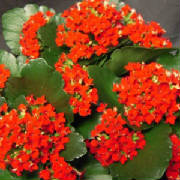
that is forced to bloom at Christmas will not
bloom the first spring it is planted but should reward you for years after. Begonias and impatiens do very well in our
winter landscapes. Impatiens need frost protection and can become deer candy, so containers might be the best idea for
these plants also. Kalanchoe is perennial in our area and enjoys full sun and well drained soil. Rosemary planted
in the landscape can become a small shrubby bush and will provide fresh rosemary for culinary uses year round.
Annuals are especially versatile during fall and winter adding wonderful
color to our Florida landscapes. We are fortunate that many different flowers will flourish and bloom here as the days
grow shorter cooler and shorter.
Some of the annuals available now are alyssum, begonia,
geraniums, impatiens, carnation, calendula, dianthus, gerbera daisy, dusty miller, and marguerite daisy. You can also
find traditional winter annuals like pansies, petunias, delphinium and snapdragons. There are beautiful chrysanthemums
available too. Chrysanthemums are technically perennial plants, but I treat them as annuals since they never seem to
look as good the next year for me. When you purchase chrysanthemums for fall color, choose plants covered with buds
just beginning to open for the longest period of blooms. If you want to try planting seeds, try alyssum, calendula,
nasturtium and sweet peas. In most of the US many of these are spring flowers, but we are fortunate to be able to plant
these in the fall here - in fact they will do much better here in the fall when days are balmy and nights are cool.
Our sandy soil is basically infertile, so add plenty of organic material (peat or compost) and a slow release
balanced fertilizer formulated for flowers as you plant. Dig these amendments into the planting area well. This
should insure that your flowers create a lovely display. Be sure to give each plant plenty of room to grow. This
will allow for good air circulation and fewer disease problems. Always water well when planting and continue to water
daily for a week thereafter. Then weekly watering should be sufficient. You may need to add more slow release
fertilizer in two months to keep them healthy and looking good into the spring. Remove spent blooms periodically to
insure a continuous bounty of flowers.
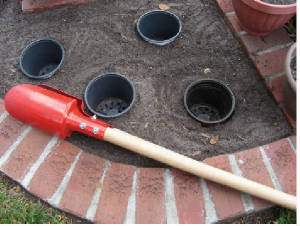
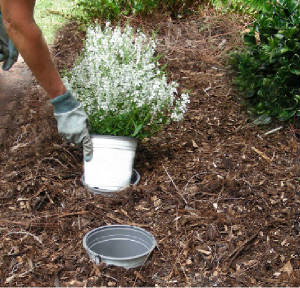
The University of Florida Extension
advocates pot-in-pot planting as a novel alternative to planting the flowers directly into the soil of a flower bed.
With this method you will plant empty nursery pots up to the top edge into the soil of the flower bed. Mulch and any
herbicide can be applied before the plants are added. You will just drop in the plants you have chosen pot and all into
the empty pots. This arrangement allows for a quick change of flowers with the change in seasons. The flowers
in these pots will need water more often and you will only need to fertilize the pots and not the whole bed. In addition,
during the winter any cold tender annuals can be lifted out and moved to a protected location if a frost or freeze is predicted.
There are usually fewer pest and disease problems as temperatures cool. Lower humidity and less rain
can decrease fungal problems. However, powdery mildew can develop when nights are cool and humidity is high for a few days,
and insect pests can still pop up. Scout your flowers often and treat as soon as you see evidence of pests. Powdery
mildew can be treated with Neem oil or a chemical fungicide, just be careful to read and follow the label carefully.
Neem will also control many of the insect pests. However, you will need to use a Bt product like Thuricide for caterpillars. Remember also that Impatiens are deer candy. So, if you want
to plant them, you might consider hanging baskets.
Some of these plants are frost sensitive. Impatiens,
geraniums and begonias will need some cover if a heavy frost is expected. With careful planning and care, you should
have colorful flowers well into spring. For additional information, access the University of Florida/IFAS Extension
publication Bedding Plants: Selection, Establishment
and Maintenance on the Internet at: http://edis.ifas.ufl.edu/pdffiles/MG/MG31900.pdf.
Pictures from University of
Florida/IFAS

